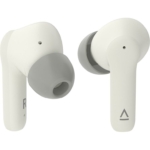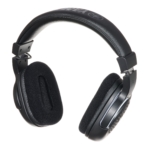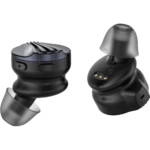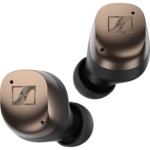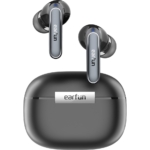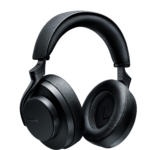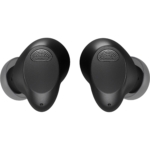I was positively impressed by the 1more ComfoBuds Mini. They are neither an audiophile gem nor a giant in terms of features, but they are a comfortable accessory for mobile and sports use that just goes to show how compact such devices can be today. In terms of sound, they offered everyday quality for daily use. Noise-cancelling helps you to escape from noisy environments, and the nice Sound ID function offers an appealing sound tuning. If you want some really small wireless headphones for daily use, you might find what you are looking for with these.
The new 1more ComfoBuds Mini are not only lightweight, thanks to their slim design they also “disappear” into your ears. Although these IPX5-certified True Wireless in-ears are confined to the audio codec formats SBC and AAC, there do have multi-level noise cancelling with transparency mode and personalised sound optimisation known as Sound ID.
The plastic 1more ComfoBuds Mini are not only extremely light, weighing less than 4 grams per earpiece, but they are also unusually small and fit just inside the ear. They are probably the first True Wireless headphones that you could sleep in. At the same time, the ComfoBuds Mini look quite stylish with their matt white or black surface.
The manufacturer specifies a runtime of six hours without ANC (at 50% level with AAC) and 24 hours with backup from the lightweight circular charging case; this can either be charged via the standard USB-C interface or by induction. A quick-charge function (ten minutes for 1.5 hours of playtime) is also provided.
In practice
The extremely compact and ergonomic design delivered exactly what I’ve always wanted from True Wireless headphones. Thanks to the four included silicone fittings, the wearing comfort was high, as well as being secure enough to let me make fast movements. The passive noise reduction was also acceptable. However, exchanging the fitting pieces was rather fiddly.
The touch control allows the user to define double and triple clicks. The functions offered include starting/pausing music playback and answering and ending phone calls. It is also possible to call up voice control in a smartphone as well as to jump tracks and control volume – but you have to choose between two functions. In addition, the noise-cancelling modes can be changed by pressing and holding the button. The configuration and any firmware updates (status: 0.10.38) can be carried out via the tried and tested 1more app for Android and iOS.
Various comfort functions can also be activated in the app. For example, the ComfoBuds Mini can automatically pause playback when the earpieces are removed and resume it later if necessary. You can also activate an automatic switch-off for when the headphones are inactive. As a rule, these headphones switch off when they are placed in the charging case, however, it makes sense to use the controls on the headphones.
As for the wireless link: pairing is quick. The Bluetooth connection was stable in combination with an iPhone and offered a reasonable range over several rooms.
Noise cancelling
According to 1more, the integrated noise cancelling is supposed to reduce noise by up to 40 dB. This is why it is also possible to choose a less powerful version in the app, and there is also a version that is supposed to reduce wind noise. In theory, there are three switchable operating modes: ANC, pass-through and inactive noise cancelling.
In practice, the noise cancellation was rather powerful even at the higher level. It eliminated annoying frequencies, especially in the bass range. A discreet background noise was present but was hardly noticeable in mobile use. In fact, the additional signal-to-noise ratio was generally an advantage. Speech remained quietly intelligible. I would recommend this mode for use when sitting down, as otherwise annoying low-frequency step noises occurred. So if you are walking, switch to the other modes. I had unexpectedly few problems with wind noise, which was probably due to the protected position of the microphones in my ears. Therefore, the special mode does not bring any added value in many cases, but could also be used as an even less potent ANC variant, this would enable higher frequencies to penetrate better.
The noise cancelling also worked sensibly during inactive music playback. The transparency mode (Pass Through) allowed environmental sound to pass through the microphones to the drivers and enable you to enter into an exchange with your environment. This worked well, but wasn’t actually fast enough, because you always have to go through all modes via the switching function.
Sound ID
The Sound ID option licensed from Sonarworks (www.sonarworks.com/soundid) is an exciting idea. It is a combination of a listening test and a sound correction in the form of an equaliser. The test is not done with test tones, instead, it uses music recordings from different genres. You choose a genre and it subsequently runs through a series of comparisons, allowing you to decide between an A and B sound variant several times. The result is an EQ curve that takes these preferences into account, but it can neither be viewed nor changed. The ID is saved with the app and can be switched on and off there.
In principle, the idea is practical and, above all, pleasantly straightforward. However, the A/B comparisons are slightly genre-dependent and cannot always be evaluated with clear preference. Thus, during the comparison, you have the option to classify the variants as identical but cannot discard both variants. In the future, I would like to be able to integrate the curve into an equaliser and, if necessary, determine it as a reference line, to regulate its intensity and, if necessary, customise it in storable presets. In fact, this is also partly possible in the Sound ID paid app by Sonarworks. However, this app does not yet feature the ComfoBuds Mini.
In short: here Sound ID provides a tone selection based on individual taste that can be permanently switched on. Since the 1more app lacks an equaliser, further corrections are not possible.
Sound
Without Sound ID, the sound of the dynamic 7 mm drivers was well-balanced, but a bit lacking in substance. The ComfoBuds Mini needed some level to get going. But even then, there was a lack of presence, especially in the low bass. I found I needed to switch on the sound ID curve because the ComfoBuds Mini have certainly not been launched with audiophile aspirations, but with the aim of providing a practical solution for everyday mobile use. And lo and behold: there was already a powerful, but somewhat exaggerated low bass. The bass range was now powerful and indeed quite well defined in terms of tonality and delineation.
In the midrange, pop and rock productions had the necessary thrust, but this was a little too much overshadowed by the bass – here it would have been good to have the aforementioned intensity control in the Sound ID profile. In addition, the treble was rather rounded, so the detail resolution, the speed and the stereo panorama suffered somewhat. There was no harshness, but as expected, there was neither the shine nor the transparency of more expensive products or even open constructions. Voices, instruments and distorted guitars, in particular, lacked bite, and dense metal productions showed a slightly disturbing midrange edge. But the price range needs to be borne in mind here: the recommended retail price is a reasonable 99.99 euros.
The voice quality was completely acceptable. This was ensured by two microphones per side and an integrated noise filter, which fades out interfering noise.
Technical specifications
- Ear couplingIn-ear
- Typeclosed
- Transducer principledynamic
- Impedance32 ohms
- Weight without cable3,7 g each, case: 34,9 g
What's in the box
- Silicone earplugs (XS, S, M, L)
- USB-C charging cable
- Charging case
Special features
- Available in black and white
- BT codecs: SBC, AAC
- BT version: 5.2
- BT profiles: A2DP, AVRCP, HFP














